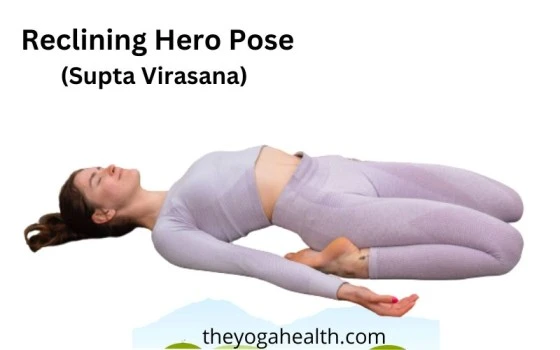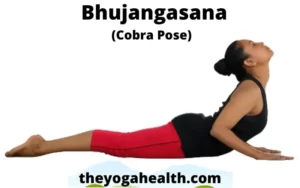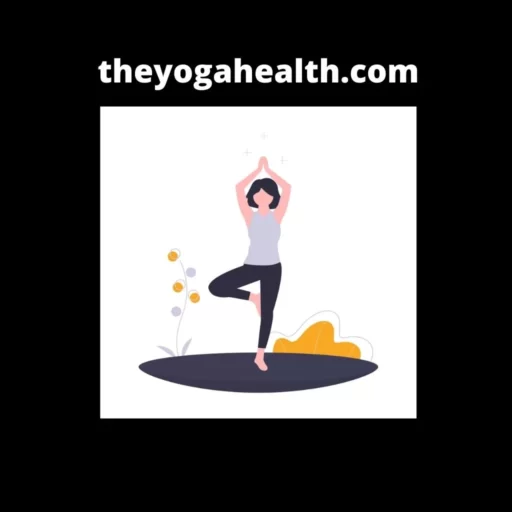In this article we’ll explore the Reclining Hero Pose, also known as Supta Virasana in the Sanskrit language. This relaxing and beneficial posture is accessible to practitioners of all levels, providing a gentle stretch to the front of the body while promoting a sense of calm and tranquillity.
Firstly, let’s understand the this Pose and its significance in yoga. Let’s explore the details of this Pose, its benefits, and how to practice it safely and effectively.
Table of Contents
What is Reclining Hero Pose (Supta Virasana)
Reclining Hero Pose, or Supta Virasana, is a reclined version of the traditional Hero Pose (Virasana). It involves lying on your back with your torso supported by the floor and your legs folded underneath you. This asana gently stretches the thighs, knees, and ankles, while also opening the chest and shoulders. This Pose is commonly used in restorative yoga practices and is an excellent posture for relaxation and meditation.
Now that we know what Supta Virasana is, let’s explore its benefits for the mind and body.
Basic Details
| Sanskrit Name | Supta Virasana |
| English Name | Reclining Hero Pose |
| Position | Supine |
| Difficulty Level | Advanced |
Benefits of Reclining Hero Pose (Supta Virasana)
1. Stretches and Strengthens the Lower Body:
This Pose provides a deep stretch to the quadriceps, thighs, and ankles, making it beneficial for those with tight muscles in these areas. As you fold your legs underneath you, it also strengthens the muscles in your legs and aids in improving flexibility over time.
2. Improves Digestion and Elimination:
In addition to the physical benefits, this Pose also offers advantages for the digestive system.
The gentle compression of the abdomen in this pose can aid in massaging the internal organs, promoting healthy digestion and regular bowel movements. Practicing this asana after a meal may help alleviate digestive discomfort.
3. Opens the Chest and Lungs:
This Pose has positive effects on the respiratory system.
By reclining backward, the chest is expanded, allowing for deeper breaths and increased lung capacity. This can be especially beneficial for individuals with respiratory issues, such as asthma, as it encourages fuller and more efficient breathing.
4. Calms the Mind and Relieves Stress:
One of the main advantages of this Pose is its calming effect on the mind.
This restful posture allows the body to relax deeply, triggering the parasympathetic nervous system, which counteracts the body’s stress response. Practicing this Pose can help reduce anxiety, promote mental clarity, and induce a sense of tranquillity.
How to Do Reclining Hero Pose (Supta Virasana)
Reclining Hero, is a rejuvenating yoga posture that provides a deep stretch to the thighs, knees, and ankles while opening the chest and shoulders. Here’s a step-by-step guide on how to practice this Pose safely and effectively:
Step 1: Start in Hero Pose (Virasana)
Begin by kneeling on the floor keeping your knees together and your feet slightly apart. Gently sit back on your heels, ensuring that your buttocks are resting comfortably on the floor or a prop, such as a yoga block or cushion. The top of your feet should be flat on the ground.
Step 2: Prepare Your Legs
Before reclining, it’s essential to ensure your legs are ready for the posture.
Check that your knees are in line with your hips and avoid letting them splay outwards. If you experience any discomfort or strain in your knees, consider using props or modifying the pose for added support.
Step 3: Recline Backward
Now, gently recline your upper body backward.
Place your palms on the floor behind you, fingertips pointing towards your body. Gradually lower your back, one vertebra at a time, until your entire torso is supported by the floor. Be mindful not to force the movement; listen to your body and find your comfortable edge.
Step 4: Open Your Chest and Shoulders
This Pose involves a gentle chest and shoulder opening.
Broaden your chest by gently drawing your shoulder blades towards each other. Relax your shoulders away from your ears, allowing your chest to open and expand. This posture encourages deep and unrestricted breathing.
Step 5: Support Your Head and Neck
To maintain proper alignment, provide support for your head and neck.
If needed, you can place a folded blanket or cushion under your head to maintain a comfortable and neutral alignment. Allow your head to rest comfortably and relax your facial muscles.
Step 6: Find Your Comfortable Edge
Remember to practice this Pose mindfully and with awareness of your body’s limitations.
Explore the depth of the stretch and find your comfortable edge. The goal is not to force your body into the deepest expression of the pose but to honor your current level of flexibility and gradually progress with regular practice.
Step 7: Breathe and Stay
Lastly, focus on conscious breathing while holding this Pose.
Take slow and deep breaths into your belly. Expand your abdomen with each inhale and release it with each exhale. Stay in the pose for a few breaths or longer, depending on your comfort level and experience.
Step 8: Release the Pose
To release this Pose, do so mindfully and gently.
Use your hands to support your back and slowly lift your torso upright. Come back to the starting position in Hero Pose, and take a moment to observe how your body feels after the stretch.
This Pose can be a deeply restorative and rejuvenating posture when practiced with proper alignment and mindfulness. With consistent practice, you’ll gradually experience the full benefits of Reclining Hero in both your body and mind.
How to Do Reclining Hero Safely
1. Warm-up:
Before attempting this Pose, a proper warm-up is essential.
Engage in gentle warm-up exercises to prepare the body for this posture. Focus on stretching the thighs, hips, and knees to ensure the muscles are adequately prepared for the deep stretch.
2. Use Props:
Props can be helpful in achieving a comfortable and safe Pose.
If you experience discomfort or strain in the knees or ankles, consider using props such as yoga blocks or a bolster to support your posture. Elevating the upper body slightly can reduce the intensity of the stretch and make the pose more accessible.
3. Gradual Progression:
As a beginner, it’s essential to progress gradually into the full expression of this Pose.
Start with a slight recline and gradually lower your upper body toward the floor, supporting yourself with your hands or props as needed. Avoid forcing your body into the posture, and listen to your body’s signals to find your comfortable edge.
Variations and Modifications
Variations and modifications, of this Pose that cater to different levels of flexibility and experience. Let’s dive in and expand our knowledge of this enriching yoga posture.
Firstly, let’s discover some exciting variations
Variations of Reclining Hero Pose
1. Reclining Supported Hero Pose:
In this variation, you can enhance the restorative benefits of the pose by using props for added support.
How to practice Reclining Hero Supported Pose:
Start by placing a bolster or a rolled-up blanket behind you in line with your spine. As you recline back, ensure that your entire spine is supported by the prop. This variation provides a gentle chest opener and a deeper sense of relaxation.
2. Reclining Hero Twist Pose:
This variation incorporates a twist to further stretch and open the chest and shoulders.
How to practice Reclining Hero Twist Pose:
From the basic pose, bend one elbow and place it on the opposite knee. Gently twist your torso towards the side of the bent knee, stretching the arm behind you. This variation adds a detoxifying element to the pose and releases tension in the upper back.
Now, let’s explore modifications for practitioners who may find the traditional Pose challenging.
Now let’s explore advanced variations of this Pose.
Advanced Variations
3. King Pigeon Pose Variation:
This variation combines the heart-opening benefits of this Pose with the deep stretch of King Pigeon Pose.
From basic Pose, bend one knee and reach back with the same-side hand to catch the foot or ankle. This variation intensifies the chest and shoulder opening, while also stretching the quadriceps and hip flexors.
4. Reclining Bound Angle Pose:
Reclining Bound Angle Pose is another advanced variation that involves deep hip and groin opening.
From the Pose, bring the soles of your feet together, allowing your knees to fall open to the sides. You can use props to support your knees if needed. This variation offers a profound stretch to the inner thighs and groins, making it an excellent preparatory pose for advanced hip-opening postures.

Modifications
With Props:
For individuals with limited flexibility in the knees or ankles, using props can make the pose more accessible.
Incorporating Props for Support
Props can be valuable allies in advancing your practice.
Utilize yoga blocks, bolsters, or blankets to support your body as needed. Props can help you maintain proper alignment and ease into challenging variations, making your practice more accessible and enjoyable.
How to practice this Pose with Props:
Place a yoga block or cushion between your feet and sit on the prop instead of directly on the floor. This modification reduces the angle of knee flexion and eases pressure on the ankles, making the pose more comfortable for those with less flexibility.
With Elevated Support:
For practitioners who find it challenging to recline all the way to the floor, an elevated support can be beneficial.
Place a bolster or several folded blankets behind you, supporting your entire spine as you recline. This modification provides a gentle stretch to the thighs and hips while offering additional comfort and ease.
Precautions and Contraindications
While this Pose has many benefits, it’s essential to be mindful of certain precautions and contraindications.
Avoid this Pose if you have severe knee, ankle, or hip injuries. If you experience discomfort in your knees or ankles during the pose, come out of it immediately and seek guidance from a yoga instructor or healthcare professional.
Tips for Alignment and Breath work
Now we’ll explore the intricacies of this Pose, offering valuable tips on alignment and breath control. Let’s take your practice to the next level and unlock the full potential of this rejuvenating posture.
Firstly, let’s understand the significance of alignment in this Pose.
Aligning Your Body in this Pose
1. Knee Alignment:
Start by kneeling on the floor with your knees together and feet slightly apart.
2. How to align your knees:
Ensure your knees are in line with your hips, and avoid letting them splay outwards. If you experience discomfort in the knees, use props or modify the pose to find a comfortable position.
3. Lower Back Alignment:
Maintaining proper alignment in the lower back is crucial for a safe practice.
As you recline backward, keep the natural curve of your lower back intact. Avoid excessive arching or rounding of the spine to prevent strain on the lumbar region.
4. Shoulder and Chest Alignment:
Opening the chest and maintaining shoulder alignment is vital for the full expression of this Pose.
Gently draw your shoulder blades towards each other to broaden your chest. Keep your shoulders relaxed and away from your ears. This alignment helps improve posture and encourages deep breathing.
Now, let’s explore the power of breath work.
Breath Control
1. Deep Diaphragmatic Breathing:
The foundation of breath work in yoga is deep diaphragmatic breathing.
As you recline in the pose, focus on breathing deeply into your belly. Inhale through your nose, expanding your abdomen, and exhale fully, allowing your belly to soften. This mindful breathing promotes relaxation and calms the mind.
2. Lengthening the Breath:
To further enhance your practice, extend your breath.
As you settle into the Pose, aim to lengthen both your inhales and exhales. Count the duration of each breath, making them smooth and even. Lengthening the breath helps regulate the nervous system and brings a sense of tranquillity.
3. Coordinating Breath with Movement:
Syncing your breath with movement can create a harmonious flow in the pose.
Inhale as you prepare to recline backward, and exhale as you gently lower your upper body to the floor. When you feel ready to come out of the pose, inhale to lift your torso back up. Coordinating breath with movement enhances the meditative aspect of this Pose.
Now, let’s delve into preparatory poses to build strength and flexibility for this Pose.
Preparatory Poses
Hero Pose (Virasana):
Hero Pose is the foundational seated posture from which Reclining Hero derives.
How to practice Hero Pose:
Kneel on the floor with your knees together and feet apart. Gently lower your hips between your feet and sit on the floor or a prop if needed. This pose stretches the thighs and prepares the knees and ankles for the reclined version.
Bridge Pose (Setu Bandha Sarvangasana):
Bridge Pose helps open the chest and shoulders, making it an excellent preparatory pose for this Pose.
Lie on your back with your knees bent and feet hip-width apart. Press into your feet and lift your hips off the floor, creating a bridge shape with your body. This pose strengthens the back and stretches the front body, preparing you for the reclined chest opening in the Pose.
Conclusion For Reclining Hero Pose:
Reclining Hero Pose (Supta Virasana) offers a wealth of benefits for the body and mind. By paying attention to proper alignment and incorporating breath work, you can refine your practice and experience even greater rewards.
Remember to approach the pose with patience and self-awareness, allowing yourself to grow and evolve on the mat. With consistent practice and dedication, you’ll unlock the true potential of this Pose.
FAQs for Reclining Hero Pose:
1. What is Reclining Hero Pose, and how is it different from Hero Pose?
This Pose, also known as Supta Virasana, is a reclined version of the traditional Hero Pose (Virasana).
In this Pose, the practitioner reclines on their back with the torso supported by the floor, and the legs are folded underneath.
Hero Pose, on the other hand, involves sitting on the floor with the buttocks resting on the heels and the spine upright.
2. Is Reclining Hero Pose suitable for beginners?
This Pose can be accessible to beginners, but it may require some modifications based on individual flexibility.
It’s essential for beginners to warm up properly and use props, such as yoga blocks or cushions, for added support and comfort.
3. What are the benefits of Reclining Hero Pose?
This Pose offers numerous benefits, including stretching and strengthening the thighs, knees, and ankles.
It opens the chest and shoulders, improves digestion, calms the mind, and promotes relaxation.
Additionally, this pose is known for its heart-opening properties and its ability to stimulate the respiratory system.
4. Can Reclining Hero Pose help with knee flexibility and joint health?
Yes, this Pose can improve knee flexibility and promote joint health when practiced correctly.
The deep stretch and gentle compression of the knees in this pose can help increase flexibility over time.
However, individuals with knee injuries or chronic knee conditions should approach this pose with caution or consult with a healthcare professional before attempting it.
5. What are the common mistakes to avoid in Reclining Hero Pose?
Common mistakes to avoid in this Pose include rounding the lower back excessively, which can strain the lumbar region.
It’s also crucial to avoid forcing the knees open if you feel discomfort; instead, use props or modify the pose as needed.
Additionally, rushing into the full expression of the pose without proper warm-up can lead to strain or injury.
6. Can Reclining Hero Pose be used for meditation and relaxation?
Yes, this Pose is often used for meditation and relaxation due to its calming and grounding effects.
When practiced with conscious breathwork, it can induce a sense of tranquility, making it an excellent posture for meditation and restorative practices.
7. Are there any contraindications for Reclining Hero Pose?
Individuals with knee, ankle, or hip injuries should avoid this Pose. Pregnant women should also be cautious, as this pose places pressure on the abdomen and may not be suitable for late stages of pregnancy.
If you have any specific health conditions, it’s advisable to consult a qualified yoga instructor or healthcare professional before attempting this pose.
8. Can Reclining Hero Pose be modified for different body types?
Yes, this Pose can be modified to suit different body types and levels of flexibility.
Using props, adjusting the height of the props, or modifying the leg position can make the pose more accessible and comfortable for various individuals.
9. How long should one hold Reclining Hero Pose during a yoga practice?
The duration of holding this Pose can vary depending on individual comfort and practice level.
Beginners may start with holding the pose for a few breaths and gradually increase the duration over time.
More experienced practitioners can hold the pose for longer periods, especially during restorative practices.
10. Can Reclining Hero Pose be used in therapeutic settings?
Yes, this Pose is sometimes used in therapeutic settings for its benefits in stretching and strengthening the lower body, promoting digestion, and opening the chest.
However, it should be approached with care and proper guidance, especially for those with specific health conditions or injuries.
Do Share your experience of doing this Pose and if you have any questions regarding this Pose you can mention so in the comments section below.







